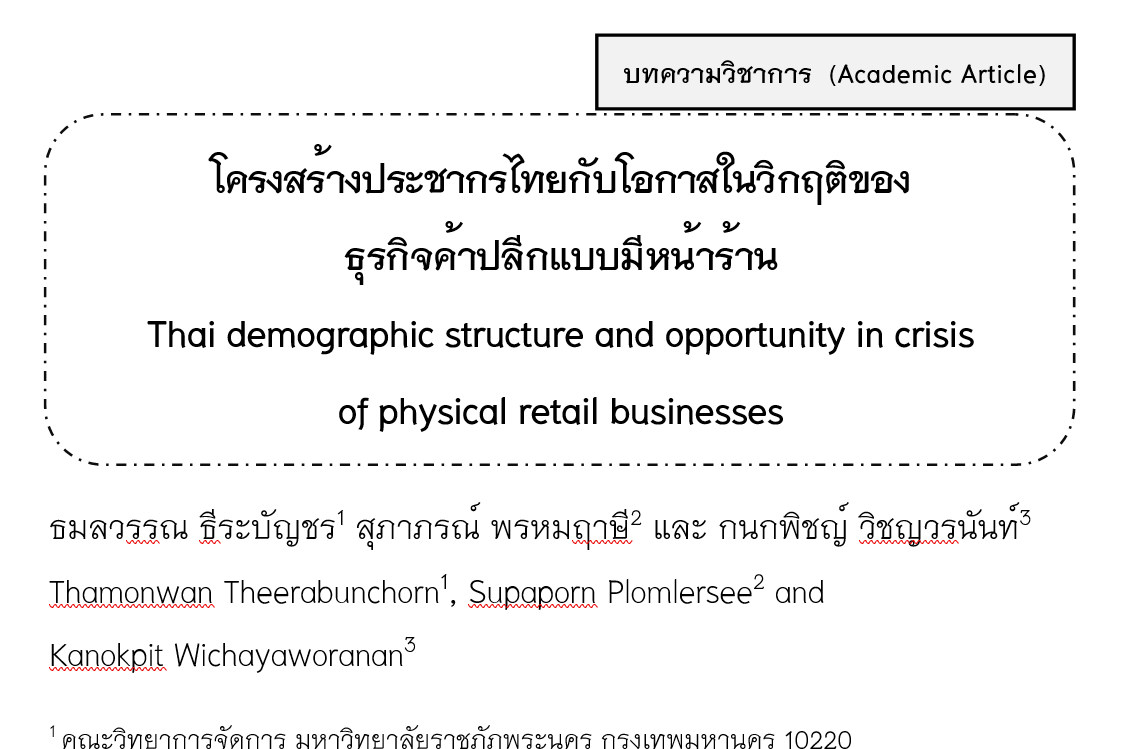Thai Demographic Structure and Opportunity in Crisis of Physical Retail Businesses
Keywords:
Retail Business, Demographic Structure, Retail Crisis, Retail OpportunitiesAbstract
Modern technology in the digital world bring about a change in the way of doing business especially in the retail business. Instead of shopping from physical store, they shop from online store. Result in a crisis of physical retail business which it has to deal with. Therefore, the objectives of this article are: 1) To study the changes in the demographic structure of Thailand 2) To study the crisis of global retail business and Thailand 3) To explore the opportunities of the physical retail business. The study founds that the market competition in the retail business that has new entrants such as online stores. They facilitate shopping from anywhere in the world, 24 hours a day, hence consumers changing their behavior towards online shopping more. As a result, sales through the physical retail business decreased and some business had to be closed. However, in the crisis, there is an opportunity arising from the change in the demographic structure of Thailand towards an aging society. Whose behavior likes to meet and socialize with friends outside the home and the target location for them is a physical retail store. The physical retail business will have to adapt to seek opportunities in the development of space utilization in existing stores that focus on selling into a space of experience. And innovations are used to help facilitate the elderly who come to use the service,
which will be a way for businesses to survive.
References
กรมกิจการผู้สูงอายุ. (2562). สถิติผู้สูงอายุของประเทศไทย 77 จังหวัด. กรุงเทพฯ: กรมการปกครองกระทรวงมหาดไทย.
นภัสร์นลิน เลิศดำรงค์ไชย. (2563). พฤติกรรมด้านการใช้พื้นที่ของผู้สูงอายุในห้างสรรพสินค้าในเขตกรุงเทพมหานคร กรณีศึกษา: พาต้าปิ่นเกล้า เอ็มบีเคเซ็นต์เตอร์ จัตุรัสจามจุรีสแควร์ และเทสโก้โลตัสพระราม 1. สาระศาสตร์, 69(1), 183-195.
มูลนิธิสถาบันวิจัยและพัฒนาผู้สูงอายุไทย. (2561). สถานการณ์ผู้สูงอายุไทย พ.ศ. 2561. กรุงเทพฯ: มหาวิทยาลัยมหิดล.
ศูนย์วิจัยกสิกรไทย. (2561). ตลาดผู้สูงวัยขุมทองของ SME ไทย. กรุงเทพฯ: ธนาคารกสิกรไทย.
ศูนย์วิจัยธนาคารออมสิน. (2562). ธุรกิจค้าปลีกสมัยใหม่. กรุงเทพฯ: ธนาคารออมสิน.
สำนักงานปลัดกระทรวงการพัฒนาสังคมและความมั่นคงของมนุษย์. (2558). สถานการณ์และ แนวโน้มสังคมผู้สูงอายุไทย พ.ศ. 2556-2573. กรุงเทพฯ: กระทรวงการการพัฒนาสังคมและความมั่นคงของมนุษย์.
สำนักงานปลัดกระทรวงการพัฒนาสังคมและความมั่นคงของมนุษย์. (2559). ประชากรสูงอายุอาเซียน. กรุงเทพฯ: กระทรวงการการพัฒนาสังคมและความมั่นคงของมนุษย์.
สำนักนโยบายและแผนสำนักงานบริหารและพัฒนาองค์ความรู้ (องค์การมหาชน). (2558). ก้าวสู่สังคมสูงวัยไอเดียดีโอกาสมา. กรุงเทพฯ: บริษัทโคคูน แอนด์ โค จำกัด.
CBInsights. (2019). Emerging Retail Trends in 2019. New york: CBInsight.
Cognizant. (2018). Retail’s Next Frontier. United States of America: Cognizant.
Chuprina, R. (2019). Artificial Intelligence for Retail and Marketing in 2019. Research Gate, 278(1874), 135-168.
Deloitle. (2017). Global Powers of Retailing 2017. United Kingdom: Deloitte Touche Tohmatsu Limited.
Infosys. (2019). The Future of Shopping: How changing consumer habits are inspiring physical store transformation. India: Infosys Limited.
Joshi, N. (2019). 7 Types of Artificial Intelligence. United States of America: Forbes.
Krugsri Research. (2020). 2020-2022 Thailand Industry Outlook. Bankok: Bank of Ayudhya.
Lachut, S. (2019). Retail Trends Playbook 2020: Creating A Data-Driven, Intelligent Retail Model. United States of America: PSFK.
Marisela, R. (2016). Towards Future Customer Experience: Trends and Innovation in Retail. Foresight and STI Governmence, 10(3), 18-28.
Statista. (2017). E-commerce share of retail slaes. Retrieved December 15, 2021, Form http://www.statiata.com/statistics/.E-commerce%20share%20of%20retail%20slaes.

Downloads
Published
How to Cite
Issue
Section
License
Copyright (c) 2022 Phayao University

This work is licensed under a Creative Commons Attribution-NonCommercial-NoDerivatives 4.0 International License.
ผู้นิพนธ์ต้องรับผิดชอบข้อความในบทนิพนธ์ของตน มหาวิทยาลัยพะเยาไม่จำเป็นต้องเห็นด้วยกับบทความที่ตีพิมพ์เสมอไป ผู้สนใจสามารถคัดลอก และนำไปใช้ได้ แต่จะต้องขออนุมัติเจ้าของ และได้รับการอนุมัติเป็นลายลักษณ์อักษรก่อน พร้อมกับมีการอ้างอิงและกล่าวคำขอบคุณให้ถูกต้องด้วย
The authors are themselves responsible for their contents. Signed articles may not always reflect the opinion of University of Phayao. The articles can be reproduced and reprinted, provided that permission is given by the authors and acknowledgement must be given.







